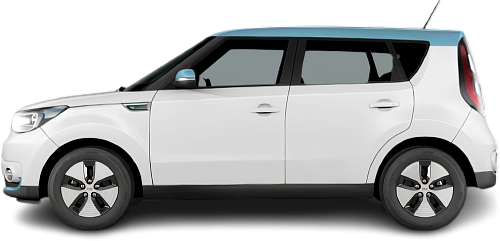Global EV Comparison: Kia Soul EV Gen 1 vs Tesla Model S Performance
Struggling to Decide? Let AI Help!
Your AI Summary Is Ready!
General Info
Since both vehicles have been discontinued, they are now only available on the used car market. You can get the Kia Soul EV (2014-2017) for as low as €8799, while the Tesla Model S Performance (2020-2021) begins at €52990.
The Kia Soul EV (2014-2017) is a SUV, whereas the Tesla Model S Performance (2020-2021) is a Liftback.
| Property | Kia Soul EV Gen 1 | Tesla Model S Performance |
|---|---|---|
| Years of Production | 2014-2017 | 2020-2021 |
| Current Status | Discontinued | Discontinued |
| Country of Manufacture | South Korea | Netherlands, USA |
| Body Style | SUV | Liftback |
| Market Availability | EU, USA | EU, USA |
| Price Europe (Used) | €8799 | €52990 |
| GCC Score | 4.5 | 7.8 |
Range and Efficiency
The Tesla Model S Performance (2020-2021) boasts a greater real-world range, a larger battery, and superior energy efficiency compared to the Kia Soul EV (2014-2017).
| Property | Kia Soul EV Gen 1 | Tesla Model S Performance |
|---|---|---|
| Range (EPA) | 150 km | 623 km |
| Range (WLTP) | - Range (WLTP) | 639 km |
| Range (GCC) | 151 km | 568 km |
| Battery Capacity (Nominal) | 30.5 kWh | 103 kWh |
| Battery Capacity (Usable) | 27 kWh | 98 kWh |
| Efficiency per 100 km | 17.9 kWh/100 km | 17.3 kWh/100 km |
| Efficiency per kWh | 5.59 km/kWh | 5.8 km/kWh |
| Range and Efficiency Score | 4.6 | 8.9 |
Charging
Both vehicles utilize a standard 400-volt architecture.
The Tesla Model S Performance (2020-2021) offers faster charging speeds at DC stations, reaching up to 250 kW, while the Kia Soul EV (2014-2017) maxes out at 50 kW.
The Tesla Model S Performance (2020-2021) features a more powerful on-board charger, supporting a maximum AC charging power of 16.5 kW, whereas the Kia Soul EV (2014-2017) is limited to 3.6 kW.
| Property | Kia Soul EV Gen 1 | Tesla Model S Performance |
|---|---|---|
| Max Charging Power (AC) | 3.6 kW | 16.5 kW |
| Max Charging Power (DC) | 50 kW | 250 kW |
| Architecture | 400 V | 400 V |
| Charge Port | CHAdeMO | Tesla Type 2 (Mennekes) |
| Charging Score | 3.2 | 8 |
Performance
The Kia Soul EV (2014-2017) is front-wheel drive, while the Tesla Model S Performance (2020-2021) offers an all-wheel drive system.
The Tesla Model S Performance (2020-2021) boasts greater motor power and accelerates faster from 0 to 100 km/h.
| Property | Kia Soul EV Gen 1 | Tesla Model S Performance |
|---|---|---|
| Drive Type | FWD | AWD |
| Motor Type | PMSM | PMSM (front), PMSM (rear) |
| Motor Power (kW) | 81 kW | 580 kW |
| Motor Power (hp) | 109 hp | 778 hp |
| Motor Torque | 285 Nm | 1140 Nm |
| 0-100 km/h | 11.2 s | 2.5 s |
| Top Speed | 145 km/h | 261 km/h |
| Performance Score | 2.4 | 8.1 |
Dimensions
The Tesla Model S Performance (2020-2021) is longer and wider, but the Kia Soul EV (2014-2017) is taller.
The Tesla Model S Performance (2020-2021) boasts a more extended wheelbase.
| Property | Kia Soul EV Gen 1 | Tesla Model S Performance |
|---|---|---|
| Length | 4140 mm | 4970 mm |
| Width (with Mirrors) | - Width (with Mirrors) | 2189 mm |
| Width (w/o Mirrors) | 1800 mm | 1964 mm |
| Height | 1593 mm | 1445 mm |
| Wheelbase | 2570 mm | 2960 mm |
Cargo and Towing
The Tesla Model S Performance (2020-2021) provides more cargo capacity, featuring both a larger trunk and more space with the rear seats folded.
A frunk (front trunk) is available in the Tesla Model S Performance (2020-2021), but the Kia Soul EV (2014-2017) doesn’t have one.
Neither vehicle is officially rated for towing in in the EU.
| Property | Kia Soul EV Gen 1 | Tesla Model S Performance |
|---|---|---|
| Number of Seats | 5 | 5 |
| Curb Weight | 1492 kg | 2316 kg |
| Cargo Volume (Trunk) | 281 l | 745 l |
| Cargo Volume (Max) | 891 l | 1645 l |
| Cargo Volume (Frunk) | - Cargo Volume (Frunk) | 60 l |
| Towing Capacity | - Towing Capacity | - Towing Capacity |
| Cargo and Towing Score | 5.4 | 5.5 |




